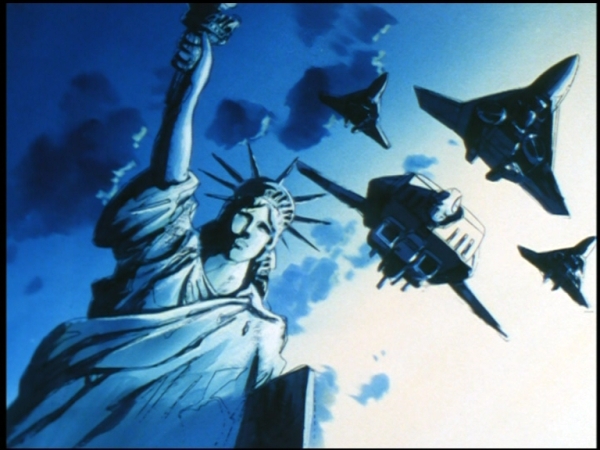Genesis Climber Mospeada
March 27, 2008 on 10:48 pm | In Mospeada | Comments Off on Genesis Climber Mospeada“Blah blah blah, I’m Stig.”

I’ve finally done it. 14 years later, I have completed the Robotech cycle in Japanese. It’s not really surprising to find that the only one that could really be justified in its endurance is Macross, with Southern Cross turning out to be a trainwreck (albeit one that was cancelled and then hastily concluded, so it feasibly could have been better), but Mospeada is an enjoyable enough romp that was, at times, laughably bad. But always in a good way.
In the 2050s, Earth was invaded by the Inbit. Some humans escaped to Mars, and in 2083 (oh my God! That’s one hundred years from now!) the Second Invasion Force descends to rescue humanity from the clutches of the Inbit. Unfortunately, just about the only soldier to survive is Stig Bernhardt. Not to survive: his freshly proposed to fiancée, and Earth’s hopes. Stig teams up with a group of rag-tag civilians, a cowardly army mechanic, and an earlier arrived soldier who gets around by pretending to be a female singer. Their goal: Reflex Point, vaguely defined as being in “North America”, and the operating point of the Inbit.
The title of the show isn’t pure nonsense: the “genesis climber” part accurately describes the Inbit’s goals, if a bit poetically, and the “mospeada” reflects the name of the bikes that our heroes ride everywhere. The two concepts don’t really meld, but then not every show that had “dimensional” in its name could justify it either, so there.
Mospeada is notable for the fact that it doesn’t really have a clearly defined hero: for some reason, despite Yellow (the amazing and frequently inexplicable dual-voiced soldier/songstress) being the senior soldier, Stig is the default leader. Stig is also the only character who has a stick up his arse about what it means to be in the military, so he doesn’t relate to the other characters that well. This is as good a time for a roll-call as any. A lot of this series is what I would call “proto”, because it gives early forms of what would later become popular standards:
Then, later:
The whole series is a logistical nightmare, with these characters frequently unable to use their vehicles for fear of appearing on the radars of the Inbit. They’ve got not just their mospeadas, but an increasing number of Legioss, combo-jet/robot fighters (hey! Just like Macross!). There are episodes where the characters are being on the down-low and so they don’t have the Legioss with them – yet they show up in the next episode when needed. This is the sort of stuff that I worry about, people!
Continuity was not king in 1983, though, and this allows dying characters to remove their shades in one shot, while still wearing them in profile in another. It takes our heroes sixteen episodes to reach “North America”, but only six after that to get to New York, which doesn’t even make any sense because Reflex Point is closer to the centre of America and they would have had to make a huge detour. The seasons also alternate between episodes, but … it’s not a good idea to pick nits. I mean, if you do that, the episode “Live-In Robbery” makes absolutely no sense and your head explodes. There are episodes where the characters will look at a place, and it’s deserted, then when the camera changes shots they are absolutely surrounded. My brain hurt several times.
But Mospeada has a nice groove, you eventually stop wanting to hit its characters, and all you can really ask for is a bit more depth. The whole show deals in surfaces, and a lot of important things seem to happen offscreen. The obligatory “disbanding of team oh wait we’ll get back together” episode is particularly forced because the characters flip out for no reason – and of course you have to wonder what Mint is doing there in the first place because she’s not even a proper loli.
You get to see some of the inner workings of the Inbit but there’s not really that much room to care for why they’re here because they really just seem like a bunch of patrol robots. The humans of Earth seem to have to obey the orders of the Inbit (which, honestly, for the most part seem to be “don’t be soldiers and try to kill us”), but it’s not until about episode 22 that you see an Inbit in robot form speak directly to a human. Even among themselves, the fiends mostly communicate non-verbally.
The series ultimately becomes one of those paradoxical war shows, the moral of which is “pacifism is awesome, let’s do that after we’ve beaten up our enemies”. That’s not necessarily a bad thing, but the whole show is just a journey to come to that conclusion, with some cool ideas along the way but a lot of repetition for a show where each episode is actually quite different to the last.
There’s just a vibe to Mospeada, I guess: I know I haven’t sold it well. That’s probably because I consider it far from essential, artificially boosted in the anime canon by its involvement in Robotech. It’s never criminally bad, has one really good (and pessimistic) episode conclusion, and it has a nice enough ending overall, but I like to think that since 1983 standards have lifted somewhat. Plus the music is awesome, and Yellow – the professional transvestite and singer, mind – tells Jim that he doesn’t want to hear any unmanly excuses. Surely that is worth the price of admission alone. Hells yeah.
No Comments yet
Sorry, the comment form is closed at this time.
Powered by WordPress with Pool theme design by Borja Fernandez.
Entries and comments feeds.
Valid XHTML and CSS. ^Top^